#279: Safe Robot Learning on Hardware, with Jaime Fernández Fisac
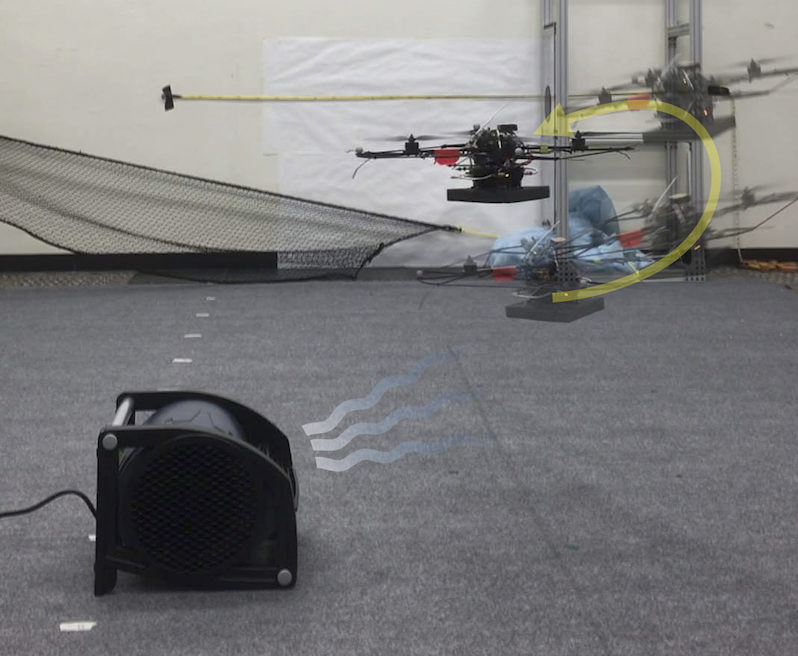
In this interview, Audrow Nash interviews Jaime Fernández Fisac, a PhD student at University of California, Berkeley, in Anca Dragan’s InterACT Lab. Fisac is interested in ensuring that autonomous systems such as self-driving cars, delivery drones, and home robots can operate and learn in the world—while satisfying safety constraints. Towards this goal, Fisac discusses different examples of his work with unmanned aerial vehicles and talks about safe robot learning in general; including, the curse of dimensionality and how it impacts control problems (including how some systems can be decomposed into simpler control problems), how simulation can be leveraged before trying learning on a physical robot, safe sets, and how a robot can modify its behavior based on how confident it is that its model is correct.
Below are two videos of work that was discussed during the interview. The top video is on a framework for learning-based control, and the bottom video discusses adjusting the robot’s confidence about a human’s actions based on how predictably the human is behaving.
Jaime Fernández Fisac
 Jaime Fernández Fisac is a final-year Ph.D. candidate in Electrical Engineering and Computer Sciences at the University of California, Berkeley. He received a B.S./M.S. degree in Electrical Engineering from the Universidad Politécnica de Madrid, Spain, in 2012, and a M.Sc. in Aeronautics from Cranfield University, U.K., in 2013. He is a recipient of the La Caixa Foundation fellowship. His research interests lie between control theory and artificial intelligence, with a focus on safety assurance for autonomous systems. He works to enable AI systems to reason explicitly about the gap between their models and the real world, so that they can safely interact with uncertain environments and human beings, even under inaccurate assumptions.
Jaime Fernández Fisac is a final-year Ph.D. candidate in Electrical Engineering and Computer Sciences at the University of California, Berkeley. He received a B.S./M.S. degree in Electrical Engineering from the Universidad Politécnica de Madrid, Spain, in 2012, and a M.Sc. in Aeronautics from Cranfield University, U.K., in 2013. He is a recipient of the La Caixa Foundation fellowship. His research interests lie between control theory and artificial intelligence, with a focus on safety assurance for autonomous systems. He works to enable AI systems to reason explicitly about the gap between their models and the real world, so that they can safely interact with uncertain environments and human beings, even under inaccurate assumptions.
Links
Mouser Electronics – TE Connectivity HDC Dynamic Module
SICK is taking safety to the next level with collaborative robot systems
Talking ATX with ABB Robotics
Video: Aircraft-inspecting suction robot successfully trialled
A Step Closer to Self-Aware Machines – Columbia engineers create a robot that can imagine itself
A new machine learning based intention detection method using first-person-view camera for Exo Glove Poly II
Streamlining Operations: Automotive Robotic Automation and Fork Truck Free Initiatives
Talking ATX West with ATI Industrial Automation
ASU’s Southwest Robotics Symposium previews the new technology guiding the next wave of human-robot interaction
Toshiba unveils robot to probe melted Fukushima nuclear fuel
A robot recreates the walk of a fossilized animal
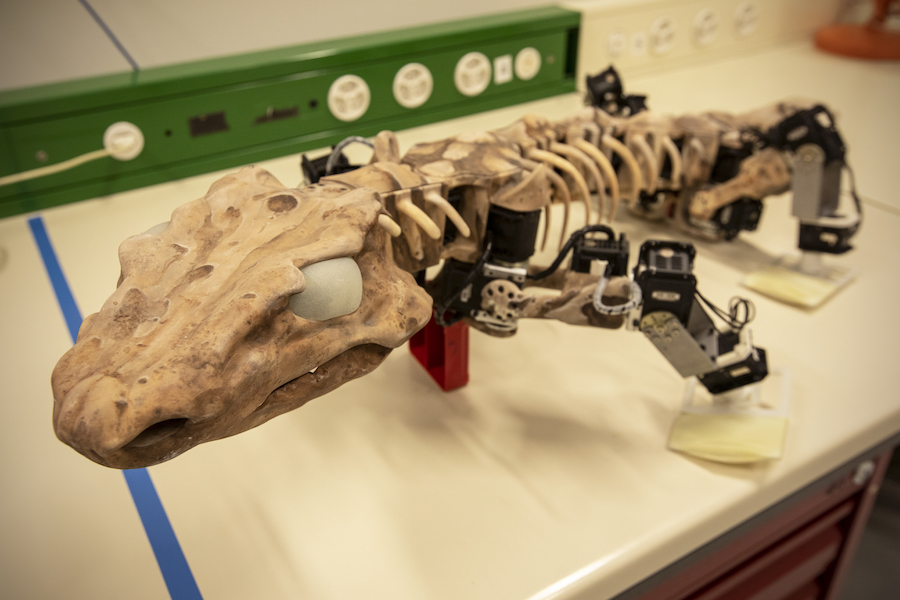
Using the fossil and fossilized footprints of a 300-million-year-old animal, scientists from EPFL and Humboldt-Universität zu Berlin have identified the most likely gaits of extinct animals and designed a robot that can recreate an extinct animal’s walk. This study can help researchers better understand how vertebrate locomotion evolved over time.
How did vertebrates walk 300 million years ago? Could they already stand upright on their legs? Did they move in a balanced, energy-efficient way? Scientists at EPFL’s Biorobotics Laboratory – supported by the National Center of Competence in Research (NCCR) Robotics – and the Interdisciplinary Laboratory Image Knowledge Gestaltung at Humboldt-Universität zu Berlin set out to answer these questions. Using the fossilized skeleton and footprints of Orobates pabsti – a vertebrate that, on the evolutionary tree, comes between amphibians on one hand and reptiles and mammals on the other – the scientists created computer simulations and a robot. Drawing on experimental studies of four living amphibian and reptile species, they used these tools to gauge how plausible different ways of walking were for the fossilized animal.
“Orobates is an ideal candidate for understanding how land vertebrates evolved because it is in the lineage leading to modern amniotes. These animals formed in eggs laid on land and became largely independent of water,” says John Nyakatura, a professor at Humboldt-Universität. What’s more, Orobates is the oldest-known vertebrate for which scientists have been able to link a fossil with its fossilized footprints. “This combination is what enabled us to carry out our unique quantitative study, which paves the way to replicating the walk of other fossilized animals,” says NCCR Robotics Professor Auke Ijspeert. The researchers’ findings appear in Nature.
A motion-based model and then a robotic one
To better understand how Orobates walked and pinpoint just how advanced its locomotion was, the scientists at Humboldt-Universität developed a digital model of its skeleton based on the animal’s fossil and the biomechanics of modern animals with sprawling postures. They used this model to carry out the first kinematic computer simulation of Orobates’ gait as it walks on its digitalized footprints. This simulation focuses on movements (rather than forces) and identifies gaits where the animal’s bones do not collide or come out of their joints.
In parallel, two scientists at EPFL’s Biorobotics Laboratory – post-doctoral researcher Kamilo Melo and PhD student Tomislav Horvat, both members of NCCR Robotics at the time of the study – used the fossilized animal anatomy to build a robot called OroBOT. Designed and scaled to match the shape and movements of the extinct animal, OroBOT was used to calculate the physics of how Orobates walked. “We tested our hypotheses about the animal’s locomotion dynamics with our robotic model, which factors in the real-world physics of the animal’s gait,” says Melo.
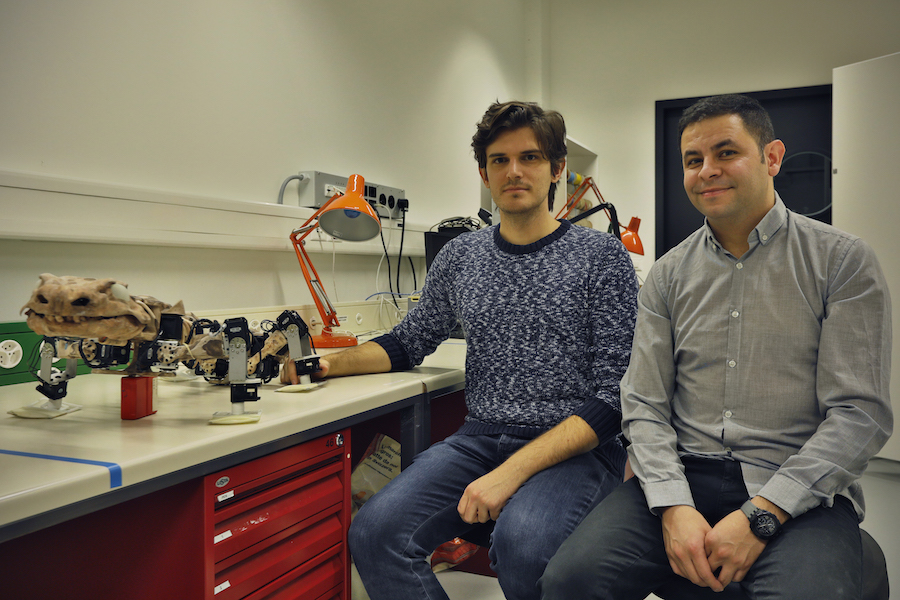
Testing hundreds of different gaits, based on contemporary animals
The interdisciplinary team of scientists tested hundreds of different gaits with their robot in order to determine which ones Orobates could have used – and those that it clearly did not. The gaits they tested were based on biomechanical principles extracted from similar modern-day animals such as caimans, salamanders, iguanas and skinks, which they analyzed through X-ray videos and force measurements. “We studied the biomechanics of their movements and determined which mechanical principles they all followed”, says Nyakatura. The research team looked at three features in particular: how erect the animal stood on its legs; how its backbone bent; and how much its elbow or shoulder joints bent as it walked. These three features determine what the researchers call the animal’s “sprawling gait space”. They created a powerful interactive website where fellow scientists – and the wider public – can explore the universe of movements that Orobates could have used.
With these results, they came up with the most likely ways that Orobates may have walked. They scored the gaits based on how much energy was required, how stable the movements were, how the leg forces compared with those of other sprawling animals, and how closely the movements aligned with the fossilized footprints. The gaits with good scores appear quite athletic and most closely resemble the movements of caimans. This suggests that Orobates probably already held itself a little upright on its legs – unlike salamanders and skinks. Its locomotion was thus more advanced — more upright, balanced and mechanically power-saving — than had been previously thought.
The study concludes that advanced locomotion, as in Orobates, may have evolved before the common ancestor of reptiles and mammals lived. The novel approach developed for this study can be applied by other scientists in their work, and it could be modified to study other evolutionary transitions, such as the origins of flight or galloping gaits in mammals. Last but not least, being able to select the most efficient gait for any given morphology is of fundamental importance for the walking robots that NCCR Robotics researchers are developing, in particular for search-and-rescue applications.
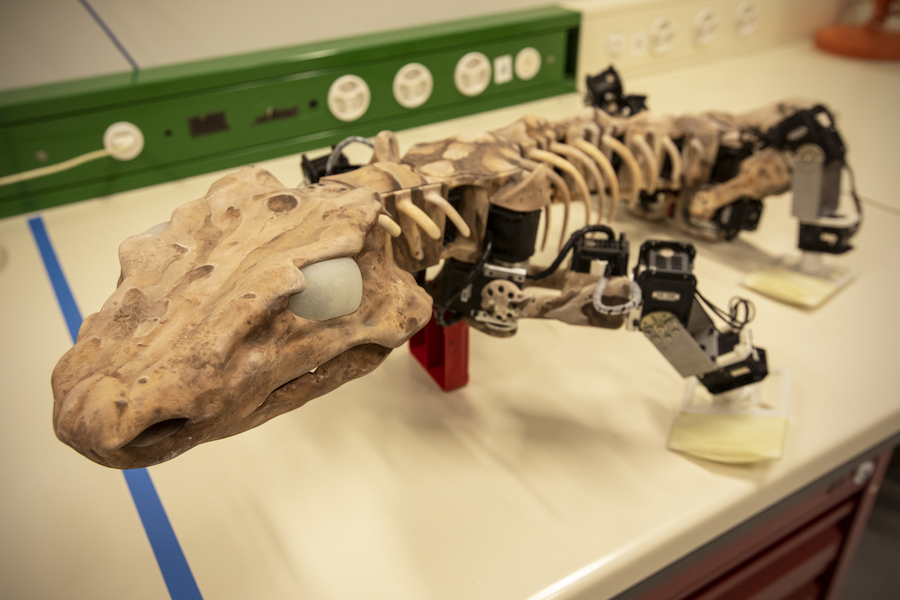
Orobates fossil
Literature
John A. Nyakatura, Kamilo Melo, Tomislav Horvat, Kostas Karakasiliotis, Vivian R. Allen, Amir Andikfar, Emanuel Andrada, Patrick Arnold, Jonas Lauströer, John R. Hutchinson, Martin S. Fischer and Auke J. Ijspeert. “Reverse-engineering the locomotion of a stem amniote“, Nature, 17 January 2019.
From robotic companions to third thumbs, machines can change the human brain
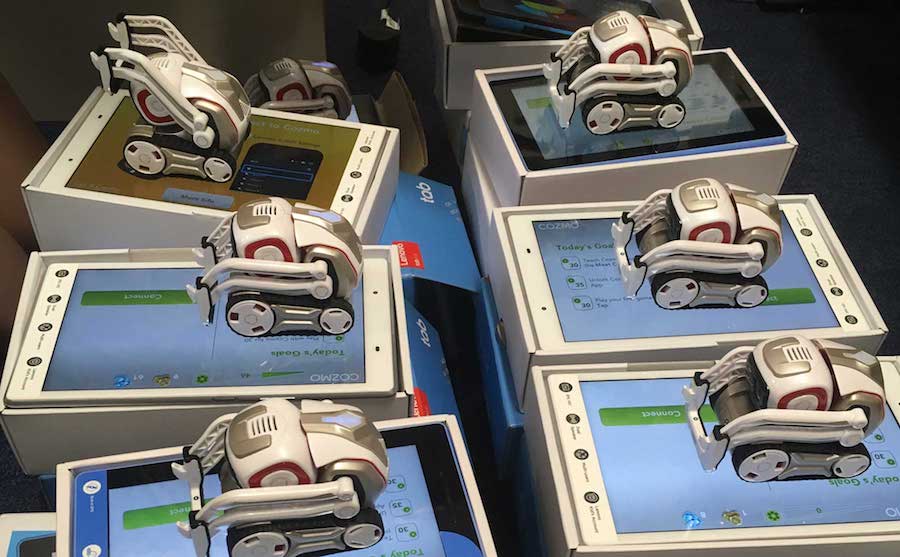
People’s interactions with machines, from robots that throw tantrums when they lose a colour-matching game against a human opponent to the bionic limbs that could give us extra abilities, are not just revealing more about how our brains are wired – they are also altering them.
Emily Cross is a professor of social robotics at the University of Glasgow in Scotland who is examining the nature of human-robot relationships and what they can tell us about human cognition.
She defines social robots as machines designed to engage with humans on a social level – from online chatbots to machines with a physical presence, for example, those that check people into hotel rooms.
According to Prof. Cross, as robots can be programmed to perform and replicate specific behaviours, they make excellent tools for shedding light on how our brains work, unlike humans, whose behaviour varies.
‘The central tenets to my questions are, can we use human-robot interaction to better understand the flexibility and fundamental mechanisms of social cognition and the human brain,’ she said.
Brain imaging shows that a sad, happy or neutral robotic expression will engage the same parts of the brain as a human face with similar expressions.
Through their project called Social Robots, Prof. Cross and her team are using neural decoding techniques to probe the extent to which human feelings towards a robot change depending on how it behaves.
Tantrums
When the robots used in the project lose a game, they alternate between throwing tantrums or appearing dejected. ‘So far, people actually find it really funny when the robot gets angry,’ she said. ‘But people do respond to them quite strongly and that’s really interesting to see.’
Having robots as colleagues has been shown to affect humans in complex ways. Researchers at the University of Washington found that when soldiers used robots in bomb disposal, they developed emotional attachments towards them and felt frustration, anger or sadness if their robot was destroyed.
Prof. Cross says that from an evolutionary perspective, this doesn’t make sense. ‘We care about people and perhaps animals that might help us or hurt us,’ she said. ‘But with machines it’s a bit more of a mystery and understanding how far we can push that (to develop social relationships with machines) is a really, really fascinating question.’
It’s important to understand these dynamics since, as she points out, robots are already working as companions in nursing homes or even as tutors in early childhood education. Home care and education are prime areas of social robotics research, with R&D efforts focusing on adults suffering from dementia and young children.
Ten-hour rule
Typically, studies on such groups observe interactions over a relatively short time-span. They rarely exceed what Prof. Cross describes as a ten-hour rule, beyond which study participants tend to get bored of their robotic toys. But her team is looking at how feelings towards robots evolve over time.
As part of the project, the researchers send a palm-sized Cozmo robot home with study participants and instruct them to interact with it every day for a week by playing games or introducing it to their friends and pets. The participants’ brains are imaged at the start and end of that period to track changes.
‘If we’re going to have robots in our home environment, if they’re going to be in our schools teaching our kids across weeks, if not years, if they’re going to be peoples’ social companions, we want to know a lot more than just what happens after ten hours’ (of exposure),’ she said.
‘We want to know how people’s social bonds and relationships to robots change across many, many more hours.’
With such technologies set to become a bigger part of our future, other studies are investigating how the brain reacts to a different kind of robot – wearable robotic limbs that augment the body, providing extra abilities.
Wearables could have social and healthcare benefits. For instance, a third arm could assist surgeons to carry out procedures more safely rather than relying on human assistants, enable people to complete their household chores much faster or help construction workers.
But even as the technology capabilities develop apace, Dr Tamar Makin, a neuroscientist at University College London, UK, is exploring what it would take for the brain to accept and operate a robotic appendage as part of the body, through a five-year project called Embodied Tech.
Additional thumb
In order to understand how the brain deals with an extra body part, Dr Makin’s team asks participants to wear an additional opposable thumb for a week. Created by a designer named Dani Clode, the thumb is controlled by pressure sensors worn on the big toes.
Product designer Dani Clode created a prosthetic opposable thumb for people to wear as an extra digit. Video credit: Dani Clode
With the additional thumb, the augmented hand almost has the capabilities of two hands, giving people extra capacity to carry out actions. The question is what effect that has on the brain.
The study is still underway but preliminary results indicate that the presence of an extra thumb alters the brain’s internal map of what the biological hand looks like. Scans show that the brain represents the fingers as collapsing onto each other, away from the thumb and index finger.
This mirrors what happens in diseases like dystonia, when the representation of fingers begins to merge – for instance, when musicians use their fingers excessively – and causes cramp-like pain. The same effect could theoretically cause pain in the wearer of an extra thumb.
‘One important interim message we have is that there are potential costs, not just benefits, to using augmentation technology,’ said Dr Makin.
She believes that the newness of human augmentation means there are lots of unanswered questions but it’s vital to explore the challenges of wearable robotics in order to fully realise the promises, such as multitasking or safer working conditions.
‘I feel like we have a responsibility to gain a much better understanding of how having good control of an additional body part is going to change the representation of the body parts you already have.’
The research in this article was funded by the European Research Council.
The news from CES is there wasn’t much news from CES
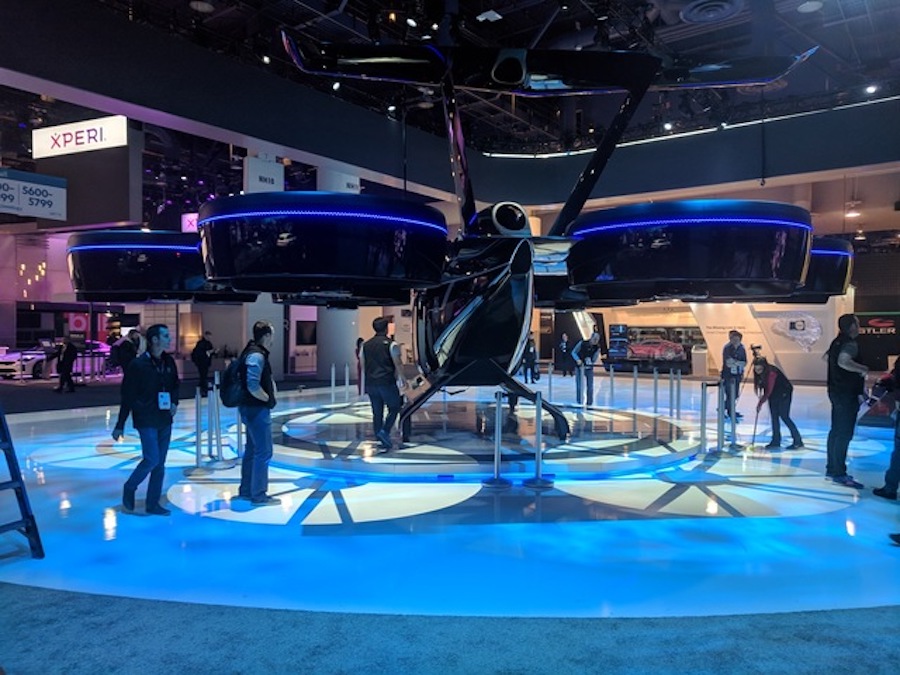
My feet are aching, as usual, after 3 days on the CES show floor, and the question people always ask others there is “what have you seen that was interesting?”
I won’t say I didn’t see anything interesting, and I had a large number of rewarding conversations with all sorts of companies, making the trip very worthwhile, but I will say I saw less that was new and exciting than ever before. This may be a result of the show’s constant growth that meant in 3 days I still did not manage to get to 3 1/2 major rooms of the show, putting my focus on cars as I usually do.
A larger fraction of CES is not even remotely consumer electronics. In fact, the reason I go is largely the robocar related companies, none of whom are selling to consumers at this time, and most of which never plan to. And yes, the amazing new TVs from Samsung, LG and others are always a draw — LG always creates an astonishing video wall, and all companies were now displaying 8K TVs as a real product (even if a very expensive one for which no video sources are available, but which will be fantastic for still photos.)
My favourite part of the show, Eureka Park, even disappointed even though I gave it most of a day. The proportion of products which are poorly thought through is always high, but you search for gems that might someday change the world. I saw few Eureka moments.
Several fields, such as Iot/Smarthome were growing and maturing, with lots more companies, but at the same time, very little in smart home moves beyond the “Oh, that sounds nice” into truly appealing and useful. I’ve had computer controlled lights for decades. They are handy, and I would rather have them than not have them, but they aren’t essentials the way my phone and a dozen apps within it are, things I can’t do without any more.
There were, again, a ton of different LIDAR companies. What’s interesting about the LIDAR crowd is that they are almost all quite different, in many cases taking entirely different approaches to the technology — the output, the steering, the sensing, the band and even the core technology. I’ll have more coverage of that later. Of course these are not for consumers.
Other press were equally unexcited — I saw far less coverage of the “hot new thing” in the media this year as the show opened and progressed. This was the year of mostly incremental improvements.
Flying car style vehicles did generate excitement, but they were barely there. The most buzz was about Bell helicopter’s “Nexus” tilt-rotor hybrid vehicle on display. It’s a high-end vehicle, with 6 giant ducted fan tilt-rotors, and very much a prototype. Bell knows a lot about tilt-rotor from their work on the V-22 Osprey, a vehicle which has a rather checkered history, so it’s not sure how this will go. The few other companies doing flying vehicles (for people) had tiny booths showing nothing.
The Nexus is a hybrid-hybrid — both multirotor and fixed-wing flight, and both electric batteries and gasoline powered generator for power.
There was some interesting battery technology, including a small startup named GBatteries which claimed that by pulsing the charge voltage they could charge at vastly faster speeds — 5C, or 10 minutes from empty to 80%, and 5 minutes to 50%, without any more heat or battery damage than today’s fast charging (which takes about an hour.) Their demo was just on a drill, so it is yet to be proven in a car, but it would change some of the usability of battery devices and electric cars.
I saw other interesting battery tech but there is some irony – because of all the investment made by Tesla and others in standard lithium ion cells, these cells are now better than other, more innovative technologies, because of their mass production (driving down the cost) and the heavy R&D (improving charge times and reducing battery degradation.) The lithium ion cell was created to be lightweight for laptops where weight is absolutely crucial, but now it’s everywhere, from cars to scooters to even grid storage.
There was an uptick of mobility products (or at least I am paying the most attention to them) beyond cars, including scooters, delivery, bike riding and more.